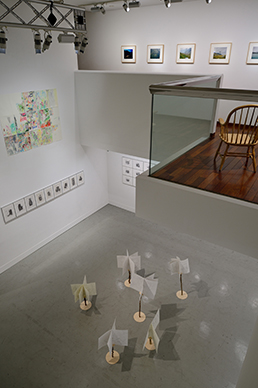Past Exhibition

< Yasutake Shimaji Performance at Shiseido Gallery, April 25, 2015 >
The Shiseido Gallery is pleased to announce the exhibition Tsubaki-kai 2015 — Shoshin (beginner’s mind), to run April 4th (Sat) through May 24th (Sun), 2015. The Tsubaki-kai is an artists’ exhibition group created in 1947, and today stands as the Shiseido Gallery’s flagship group exhibition. With each iteration, the membership of the Tsubaki-kai has continued to change, and the group remains strong even now after nearly seventy years.
The Seventh Tsubaki-kai was formed in 2013 by five artists, Genpei Akasegawa, Naoya Hatekeyama, Rei Naito, Zon Ito, and Ryoko Aoki. The thematic subtitle “Shoshin” was chosen with the March 11, 2011 disaster in mind. As Japan struggled to recover from the devastation, the members of the newly formed Tsubaki-kai agreed that such a terrible event and the inevitable rebuilding in the aftermath of it invited opportunities to reconsider the mindsets and ideas associated with “starting over” and “beginning things anew.” The Shinmeikai Japanese Dictionary defines “shoshin” as “the purity of thought and feeling experienced when first engaging or attempting something.” In discussing the wisdom underlying his art, the Noh master Zeami urges the artisan to “never forget the beginner’s mind,” a mental stance useful in confronting new experiences throughout the various stages of life.
In keeping with this idea of renewal, graphic designer Masayoshi Nakajo has also been recreating and renewing the Tsubaki-kai exhibition logo each year.
This exhibition is the third for these participating Tsubaki-kai members. Sadly, member Genpei Akasegawa passed away last October, but we nonetheless wished to keep him present in this exhibition by showing some of his past work. This includes a set of illustrated journal entries he published in a magazine from 1985 to 1988, in which he observes the everyday from his own unique perspective, giving us a view of Akasegawa as essayist and illustrator.
To the original artist roster, the Seventh Tsubaki-kai now welcomes a new member, dancer Yasutake Shimaji. Currently based in Frankfurt, Germany, Shimaji is an active member of The Forsythe Company, and during the course of the current Tsubaki-kai exhibition he will be contributing improvisational dance presentations inspired by the Tsubaki-kai works on display at the Shiseido Gallery.
Naoya Hatekeyama will present a series of photographs of giant boulders deposited across Germany by glacial action. Rei Naito will present new pieces in her “color beginning” and “human” series she has continued to exhibit since 2013. Zon Ito will present works of embroidery based on his observations last year of the living creatures dwelling in and around Tokyo’s Ginza district. Ryoko Aoki will present a number of small drawings which she has allowed to come into being through unconscious processes.
With its new member and taking its first steps toward new stages of artistic exploration and expression, this year’s Tsubakikai exhibition is certainly one not to be missed.
■Exhibiting Members
| Yasutake Shimaji | Born in Nagano, Japan in 1978. Currently resides in Frankfurt, Germany. Shimaji studied in the Theater Arts Department at Nihon University College of Art. He began studying modern dance under the guidance of Miyako Kato, and later spent 2004 to 2006 as a member of Noism in the city of Niigata. In August 2006 he joined The Forsythe Company (led by William Forsythe) in Frankfurt, where he remains an active member. In 2013 Shimaji formed the Altneu “dance unit” with fellow dancer Hana Sakai. |
|---|---|
| Genpei Akasegawa (1937–2014) | Born in Yokohama in 1937. Lived in Tokyo. Akasegawa was a painter, author, illustrator, avant-garde artist, founding member of the Street Observers Society, and defendant of the famous “1000-Yen Bill Incident.” In 1981 he won the 84th Akutagawa Literary Prize for his short story Father is Gone (written under the pseudonym Katsuhiko Otsuji). In 1989 he collaborated with Hiroshi Teshigahara on the screenplay for the film Rikyu, which won a Best Screenplay Award from the Japan Academy. Akasegawa’s published works include: The Riddle of Mr. Shinkai; Hyper-Art Thomasson; Elderly Power; and The Pleasures of a Personal Art Museum. A phrase from the Japanese title of Elderly Power even entered the popular lexicon in 1998. Akasegawa’s most recent exhibitions have included Overflowing Images: Printed Media & Arts After the Anti-Art 1960s–70s (2008) at the Urawa Museum of Art; Akasegawa Genpei’s Photographic Walks (2010) at Yokohama City Public Gallery Azamino; TOKYO 1955–1970 / Avant-garde Arts (2012–13) at the Museum of Modern Art in New York; Hi-Red Center: The Documents of Direct Action (2013) at the Nagoya City Art Museum and the Shoto Museum of Art; Katsuhiko Otsuji × Genpei Akasegawa: A Polyhedron of Literature & Art (2014) at Machida City Kotoba Land; and Genpei Akasegawa’s Principles of Art: 1960s–Present (2014–15) at the Chiba City Art Museum, Oita Art Museum, and Hiroshima City Museum of Contemporary Art. Akasegawa’s work has been collected by the Nagoya City Art Museum; the Hiroshima City Museum of Contemporary Art; the Hyogo Prefectural Museum of Art; and the Walker Art Center in Minneapolis. |
| Naoya Hatakeyama | Born in Rikuzentakata, Iwate in 1958. Lives in Tokyo. Hatakeyama studied photography under Kiyoji Otsuji at the University of Tsukuba’s School of Art and Design, completing postgraduate studies there in 1984. Since then he has been based in Tokyo, focusing on photographic series showing the relationships between nature, cities, and photography. In 2001 Hatakeyama exhibited along with Masato Nakamura and Yukio Fujimoto in the Japanese Pavilion at the 49th Venice Biennale. His work has been shown in numerous solo and group exhibitions in Japan and abroad, including Naoya Hatakeyama: Natural Stories at the Tokyo Metropolitan Museum of Photography (2011) for which he the Minister of Education, Culture, Sports, Science, and Technology’s Art Encouragement Prize of Fine Arts. In 2012, he participated in the Japanese Pavilion at the Venice Biennale’s 13th International Architecture Exhibition (earning the Leone d’Oro award). Hatakeyama’s works have been collected by the National Museum of Art, Osaka; the National Museum of Modern Art, Tokyo; the Tokyo Metropolitan Museum of Photography; the Museum of Fine Arts, Houston; the Maison Européenne de la Photographie (Paris); and the Victoria & Albert Museum (London). |
| Rei Naito | Born in Hiroshima in 1961. Lives in Tokyo. Naito earned a degree in visual communication design from the College of Art and Design, Musashino Art University in 1985. She gained recognition for One Place on the Earth at the Sagacho Exhibit Space in 1991, and she later showed this work in the Japanese Pavilion at the Venice Biennale in 1997. Her major solo exhibitions have included: Migoto ni harete otozureru wo mate at the National Museum of Art, Osaka (1995); Being Called at the Galerie im Karmeliterkloster, Frankfurt am Main (1997); Giving Back / Reconnaissance at the Asahi Beer Oyamazaki Villa Museum, Kyoto (2005); matrix at the Nizayama Forest Art Museum, Toyama (2007); Tout animal est dans le monde comme de l’eau à l’intérieur de l’eau at the Museum of Modern Art, Kamakura (2009); and the emotion of belief at the Tokyo Metropolitan Teien Art Museum(2014). Permanent work include Being given at Kinza, an Art House Project, Naoshima, Kagawa (2001) and matrixat the Teshima Art Museum (2010). Naito’s works have been collected by the National Museum of Art, Osaka; the Museum für Moderne Kunst, Frankfurt am Main; the Museum of Modern Art, New York; and the Israel Museum (Jerusalem). |
| Zon Ito | Born in Osaka in 1971. Lives in Kyoto. Ito graduated from Kyoto City University of Arts in 1996. He has presented ra variety of styles of work including embroidered textiles, animation, drawing, and sculpture. His domestic and international exhibitions have included: The End of the Neighborhood at the WATARI-UM, the Watari Museum of Contemporary Art, Tokyo (2003); Three Individuals at the National Museum of Art, Osaka (2006); Louisa Bufardeci & Zon Ito at the Museum of Contemporary Art, Sydney (2009); Primary Field II at the Museum of Modern Art, Hayama (2010–11); Ways of Worldmaking at the National Museum of Art, Osaka (2011); Beppu mimicry (KASHIMA 2012 BEPPU ARTIST IN RESIDENCE), Oita (2012); Now Japan at KAdE Kunsthal, Amersfoort (2013–14); and Isobe-yu Gallery/Isobeyu Bathhouse Restoration Project, Maebashi (2013). Ito’s works have been collected by museums including the Walker Art Center in Minneapolis; The WATARI-UM the Watari Museum of Contemporary Art, Tokyo; the Museum of Contemporary Art, Tokyo; the Takamatsu City Art Museum; and the National Museum of Art, Osaka. |
| Ryoko Aoki | Born in Hyogo in 1973. Lives in Kyoto. MFA in visual design from Kyoto University of Fine Art. Aoki’s works are often comprised of sketches of a variety of images including plants and animals, fragments of daily life, and geometric patterns. Her major solo exhibitions have included: CRITERIUM 51 at Art Tower Mito, Ibaraki (2002); HAMMER PROJECT Ryoko Aoki at the UCLA Hammer Museum, Los Angeles (2005–06); and Seeds of Wildflower at On Sundays, Tokyo (2010). Her major group exhibitions have included: Documenta 12 in Kassel (2007); The Door into Summer: The Age of Micropop at Art Tower Mito, Ibaraki (2007); Winter Garden (2009) at the Hara Museum of Contemporary Art, Tokyo; Garden of Painting: Japanese Art of the 00s at the National Museum of Art, Osaka (2010); You reach out –right now- for something: Questioning the Concept of Fashion at Art Tower Mito and the Marugame Genichiro-Inokuma Museum of Contemporary Art (2014); and Chronicals 1995– for the 20th Anniversary MOT Special Collection at the Museum of Contemporary Art, Tokyo (2014). Aoki’s works have been colleted by museums including the Museum of Modern Art, New York; Takamatsu City Art Museum; and the Museum of Contemporary Art, Tokyo. |
■Photo Reference

Photo: Anju

from the series Findling: Markgrafensteine (2009)

Photo by Naoya Hatakeyama

■Related Events
| (1) Dance Performance by Yasutake Shimaji | |
| Date & Time: | April 25th (Sat) 7:15PM–8:00PM |
| Place: | Shiseido Gallery |
| Capacity: | 30 guests (selected by lottery if requests exceed capacity) |
| Participation Fee: None | |
| (2) Gallery Talk: Zon Ito | |
| Date & Time: | May 17th (Sun) 2:00PM–4:00PM |
| Place: | Word Hall, Tokyo Ginza Shiseido Building, 9th Floor |
| Capacity: | 60 guests (selected by lottery if requests exceed capacity) |
| Participation Fee: None | |
| Inquiries: | The Shiseido Gallery (Tel 03-3572-3901 or Fax 03-3572-3951) |
■Exhibition Details for Tsubaki-kai 2015 — Shoshin
| Organized by Shiseido Co., Ltd. | |
| Duration: | April 4 (Sat) to May 24 (Sun), 2015 |
| Location: |
The Shiseido Gallery Tokyo Ginza Shiseido Building, B1, 8-8-3 Ginza, Chuo-ku, Tokyo 104-0061 Tel:03-3572-3901; Fax:03-3572-3951 |
| Hours: |
Weekdays: 11:00 AM - 7:00 PM, Sundays and National Holidays: 11:00 AM - 6:00 PM Closed on Monday (including public holidays) |
| Admission is free | |